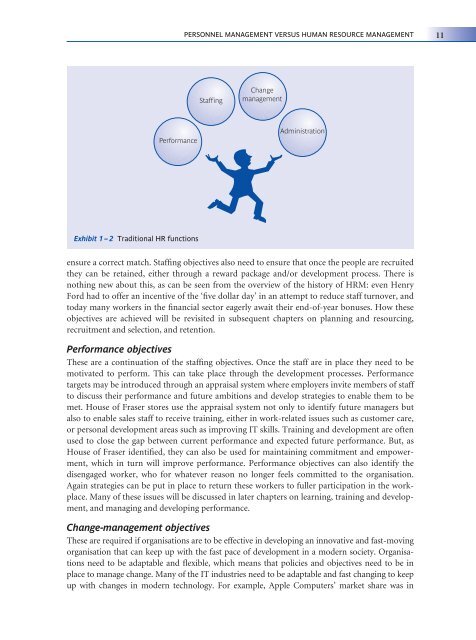The role of human resource management
The role of human resource management
The role of human resource management
You also want an ePaper? Increase the reach of your titles
YUMPU automatically turns print PDFs into web optimized ePapers that Google loves.
Performance<br />
Exhibit 1–2 Traditional HR functions<br />
PERSONNEL MANAGEMENT VERSUS HUMAN RESOURCE MANAGEMENT 11<br />
Staffing<br />
Change<br />
<strong>management</strong><br />
Administration<br />
ensure a correct match. Staffing objectives also need to ensure that once the people are recruited<br />
they can be retained, either through a reward package and/or development process. <strong>The</strong>re is<br />
nothing new about this, as can be seen from the overview <strong>of</strong> the history <strong>of</strong> HRM: even Henry<br />
Ford had to <strong>of</strong>fer an incentive <strong>of</strong> the ‘five dollar day’ in an attempt to reduce staff turnover, and<br />
today many workers in the financial sector eagerly await their end-<strong>of</strong>-year bonuses. How these<br />
objectives are achieved will be revisited in subsequent chapters on planning and resourcing,<br />
recruitment and selection, and retention.<br />
Performance objectives<br />
<strong>The</strong>se are a continuation <strong>of</strong> the staffing objectives. Once the staff are in place they need to be<br />
motivated to perform. This can take place through the development processes. Performance<br />
targets may be introduced through an appraisal system where employers invite members <strong>of</strong> staff<br />
to discuss their performance and future ambitions and develop strategies to enable them to be<br />
met. House <strong>of</strong> Fraser stores use the appraisal system not only to identify future managers but<br />
also to enable sales staff to receive training, either in work-related issues such as customer care,<br />
or personal development areas such as improving IT skills. Training and development are <strong>of</strong>ten<br />
used to close the gap between current performance and expected future performance. But, as<br />
House <strong>of</strong> Fraser identified, they can also be used for maintaining commitment and empowerment,<br />
which in turn will improve performance. Performance objectives can also identify the<br />
disengaged worker, who for whatever reason no longer feels committed to the organisation.<br />
Again strategies can be put in place to return these workers to fuller participation in the workplace.<br />
Many <strong>of</strong> these issues will be discussed in later chapters on learning, training and development,<br />
and managing and developing performance.<br />
Change-<strong>management</strong> objectives<br />
<strong>The</strong>se are required if organisations are to be effective in developing an innovative and fast-moving<br />
organisation that can keep up with the fast pace <strong>of</strong> development in a modern society. Organisations<br />
need to be adaptable and flexible, which means that policies and objectives need to be in<br />
place to manage change. Many <strong>of</strong> the IT industries need to be adaptable and fast changing to keep<br />
up with changes in modern technology. For example, Apple Computers’ market share was in

















